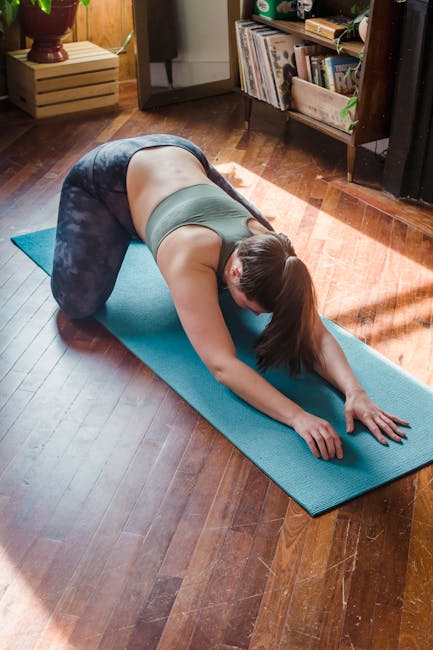What Are The Benefits Of Movement Meditation For Emotional Release?
Feeling emotionally stuck or overwhelmed can feel like carrying a heavy backpack you can’t take off. But what if I told you there’s a way to gently unpack those emotions while moving your body? Movement meditation is a practice that combines physical activity with mindfulness, offering a powerful tool for emotional release.
This practice doesn’t just help you feel better emotionally—it also improves your physical health and overall well-being. Keep reading to discover how movement meditation can transform your relationship with your emotions and help you feel lighter, freer, and more connected to yourself.
Key Takeaways
- Movement meditation blends physical activity with mindfulness to release pent-up emotions.
- It offers physical benefits like reduced pain and improved flexibility.
- Emotionally, it helps reduce stress, increase awareness, and foster healing.
- Techniques like yoga, dance, and breathwork make it accessible to everyone.
- Incorporating it into daily life can lead to long-term emotional balance.
Introduction to Movement Meditation
Definition of Movement Meditation
Movement meditation is a practice where you focus on your body’s movements while staying present in the moment. Unlike traditional seated meditation, this approach involves flowing through physical activities like yoga, tai chi, or even free-form dance. It’s all about connecting your mind and body through intentional movement.
Overview of Its Purpose for Emotional Release
The purpose of movement meditation is to help you process and release emotions stored in your body. Think of it as a way to shake off emotional cobwebs. When you move mindfully, you create space for feelings to surface, be acknowledged, and let go. It’s a gentle yet powerful way to heal emotional wounds.
Importance of Connecting Body and Mind
Your body and mind are like dance partners—they work best when they’re in sync. Movement meditation strengthens this connection, helping you understand how emotions manifest physically. For example, stress might show up as tight shoulders, while sadness could feel like a heavy chest. By tuning in, you can address these sensations and find relief.

Physical Benefits of Movement Meditation
Relief from Chronic Pain
How Somatic Movement Alleviates Physical Discomfort
Chronic pain often has emotional roots. Practices like somatic movement—a form of movement meditation—can help release tension stored in your muscles. By moving mindfully, you can identify areas of discomfort and gently work through them. According to this article, somatic movement helps rewire your brain’s connection to your body, reducing pain over time.
Connection Between Physical Relief and Emotional Release
When your body feels better, your emotions often follow suit. Releasing physical tension can unlock emotional blockages, allowing you to process feelings you didn’t even know you were holding onto. It’s like peeling back layers of an onion—each layer brings you closer to emotional clarity.
Increased Flexibility and Mobility
Enhancing Physical Comfort
Movement meditation improves flexibility and mobility, making your body feel more at ease. Whether it’s through yoga poses or gentle stretches, these practices help you move more freely, reducing stiffness and discomfort.
Supporting Emotional Expression Through Improved Movement
When your body moves with ease, it becomes a better vessel for emotional expression. Think about how a joyful dance or a cathartic stretch can help you release pent-up feelings. Improved mobility makes it easier to let emotions flow naturally.

Emotional Benefits of Movement Meditation
Reduction of Anxiety and Stress
Relaxation Through Movement
Movement meditation is like a moving lullaby for your nervous system. The rhythmic motions and mindful breathing calm your mind, reducing anxiety and stress. If you’re looking for more ways to manage stress, check out this guide on how exercise can help.
Mood-Boosting Effects of Physical Activity
Physical activity releases endorphins, your brain’s natural feel-good chemicals. Combine that with the mindfulness of meditation, and you’ve got a recipe for a brighter mood. It’s like giving your brain a warm hug.
Emotional Awareness and Understanding
Becoming More in Touch with Emotions
Movement meditation helps you tune into your emotions by focusing on how they feel in your body. For instance, anger might feel like heat in your chest, while fear could feel like a knot in your stomach. Recognizing these sensations is the first step toward understanding and releasing them.
Fostering a Deeper Connection to Emotional States
By practicing regularly, you’ll develop a deeper connection to your emotional landscape. This awareness can help you respond to emotions with compassion instead of reacting impulsively. For more on enhancing emotional well-being, explore this article.

Role of Movement Meditation in Trauma Healing
Processing and Releasing Stored Emotions
How Movement Aids in Trauma Recovery
Trauma often gets stored in the body, creating physical and emotional tension. Movement meditation provides a safe way to process these feelings without words. Practices like yoga and dance have been shown to help trauma survivors reconnect with their bodies and release stored emotions.
Examples of Movements That Facilitate Emotional Release
Gentle yoga poses, free-form dancing, and even shaking exercises can help release trauma. These movements encourage your body to let go of tension and create space for healing.
Creating a Safe Space for Emotional Exploration
Importance of Non-Judgmental Practices
Movement meditation is all about self-compassion. There’s no right or wrong way to move—it’s about what feels good for you. This non-judgmental approach creates a safe space for emotional exploration.
Building Resilience Through Movement
By regularly practicing movement meditation, you build emotional resilience. Each session strengthens your ability to face and process difficult emotions, making you more adaptable in the face of life’s challenges.

Techniques and Practices in Movement Meditation
Mind-Body Exercises
Yoga for Emotional Release
Yoga is a popular form of movement meditation that combines physical poses with mindful breathing. Certain poses, like child’s pose or pigeon pose, are particularly effective for releasing emotions.
Dance and Martial Arts as Expressive Outlets
Dance and martial arts offer dynamic ways to express emotions. Whether it’s a slow, flowing dance or a powerful martial arts sequence, these practices help you channel your feelings into movement.
Breathwork and Body Awareness
Diaphragmatic Breathing for Tension Release
Deep breathing is a cornerstone of movement meditation. Diaphragmatic breathing, in particular, helps release tension and calm your nervous system. For more on relaxation techniques, check out this resource.
Body Scan Meditation for Emotional Regulation
A body scan meditation involves mentally checking in with each part of your body. This practice helps you identify areas of tension and release them, promoting emotional balance.
How to Incorporate Movement Meditation into Daily Life
Setting Intentions for Emotional Release
Before you begin, set an intention for your practice. Whether it’s to release stress or process a specific emotion, having a clear goal can make your session more meaningful.
Choosing the Right Practice for Individual Needs
Not all movement meditation practices are the same. Experiment with different techniques—like yoga, dance, or tai chi—to find what resonates with you. For more ideas, explore this article.
Creating a Consistent Routine for Long-Term Benefits
Consistency is key. Even just 10 minutes a day can make a big difference over time. Find a routine that fits your schedule and stick with it.

Conclusion
Recap of the Benefits of Movement Meditation for Emotional Release
Movement meditation offers a holistic way to release emotions, combining physical activity with mindfulness. It reduces stress, improves flexibility, and fosters emotional awareness, making it a powerful tool for healing.
Encouragement to Explore and Personalize Practices
There’s no one-size-fits-all approach to movement meditation. Experiment with different techniques and personalize your practice to suit your needs. The journey is as important as the destination.
Final Thoughts on the Transformative Power of Movement Meditation
Movement meditation is more than just exercise—it’s a way to reconnect with yourself on a deeper level. So why not give it a try? Your mind, body, and emotions will thank you. For more inspiration, explore this guide.
FAQ: Discovering the Benefits of Movement Meditation for Emotional Release
What is movement meditation, and how does it differ from traditional meditation?
Movement meditation involves physical motion, such as walking, dancing, or yoga, to help focus the mind and release emotions. Unlike traditional seated meditation, it integrates the body and mind, making it ideal for those who find stillness challenging or seek a more dynamic approach to mindfulness.
How does movement meditation help with emotional release?
Movement meditation encourages the body to express and release pent-up emotions through physical motion. It allows individuals to process feelings in a non-verbal way, often leading to a sense of relief and emotional clarity.
What are some common types of movement meditation practices?
Popular forms of movement meditation include yoga, tai chi, qigong, ecstatic dance, and mindful walking. Each practice combines intentional movement with focused breathing and awareness, fostering emotional and physical well-being.
Can movement meditation reduce stress and anxiety?
Yes, movement meditation can significantly reduce stress and anxiety by promoting relaxation, releasing tension, and encouraging mindfulness. The rhythmic movements and deep breathing help calm the nervous system and create a sense of inner peace.
Is movement meditation suitable for beginners?
Absolutely! Movement meditation is highly accessible and can be adapted to suit all fitness levels and abilities. Beginners can start with simple practices like mindful walking or gentle stretching, gradually exploring more complex forms as they feel comfortable.
How often should I practice movement meditation for emotional benefits?
Consistency is key. Practicing movement meditation a few times a week, even for 10-20 minutes, can yield noticeable emotional benefits. Over time, regular practice can enhance emotional resilience and overall well-being.
Can movement meditation improve physical health as well?
Yes, movement meditation offers physical benefits such as improved flexibility, balance, and circulation. The combination of mindful movement and controlled breathing also supports cardiovascular health and reduces muscle tension.
What role does breathing play in movement meditation?
Breathing is a fundamental aspect of movement meditation. It helps synchronize the body and mind, deepens relaxation, and enhances the release of emotions. Conscious breathing also anchors awareness in the present moment, amplifying the meditative experience.
Are there any scientific studies supporting the benefits of movement meditation?
Yes, numerous studies highlight the benefits of movement meditation for emotional and physical health. Research shows that practices like yoga and tai chi can reduce stress, improve mood, and enhance overall mental well-being.
Can movement meditation be combined with other forms of therapy for emotional healing?
Certainly! Movement meditation complements other therapeutic approaches, such as talk therapy or art therapy, by offering a physical outlet for emotions. It can enhance the healing process by addressing both the mental and physical aspects of emotional release.



